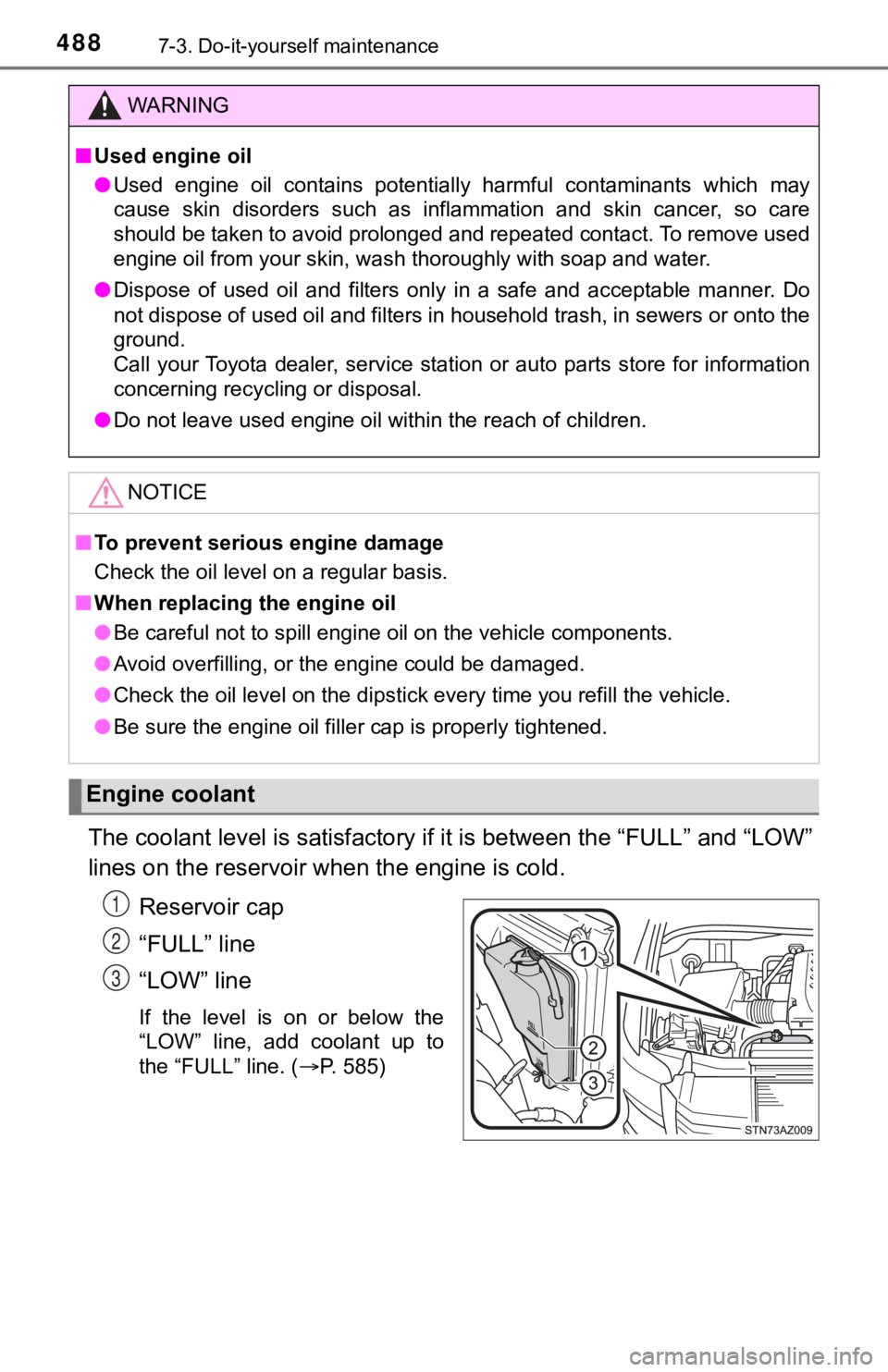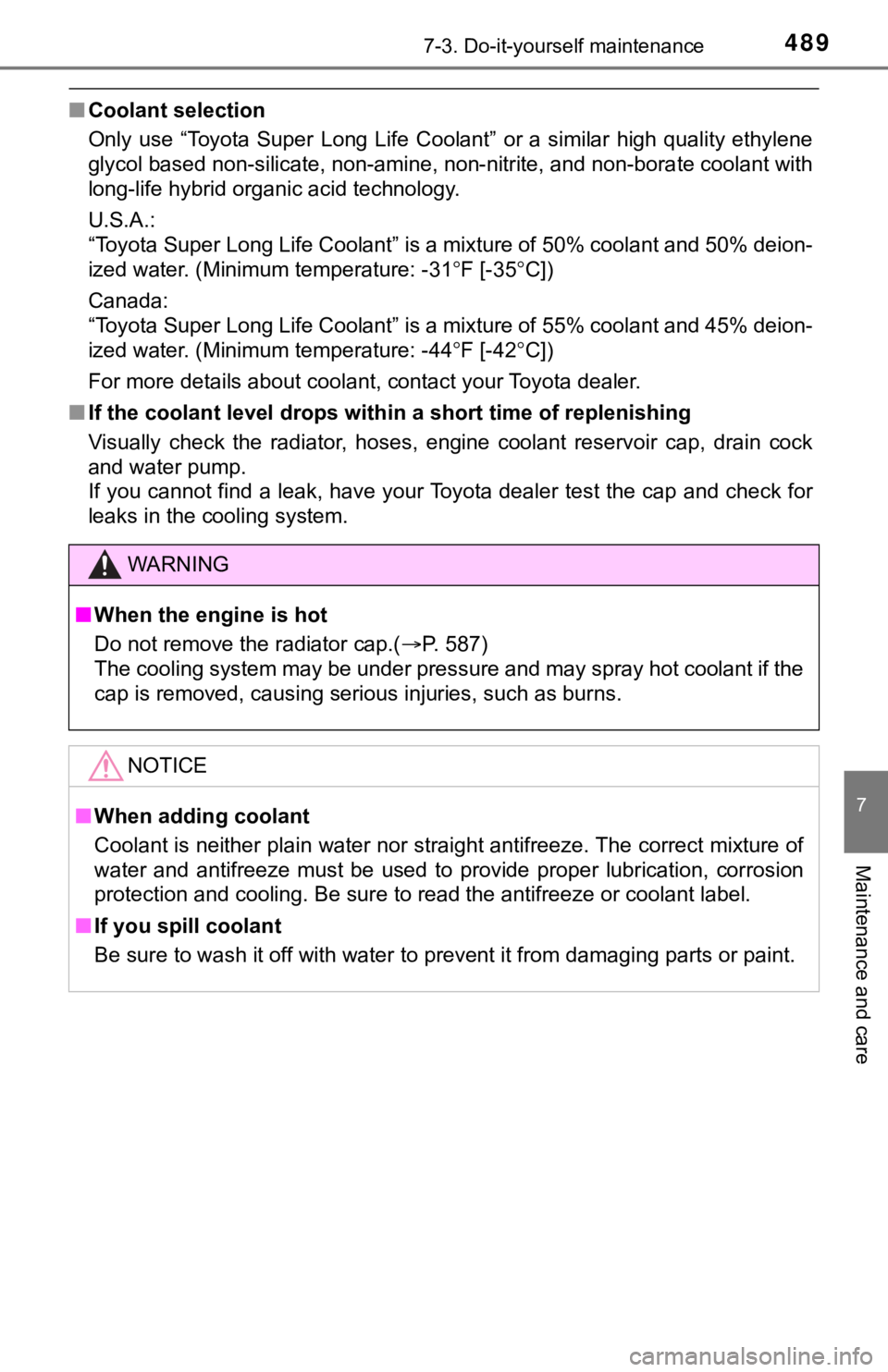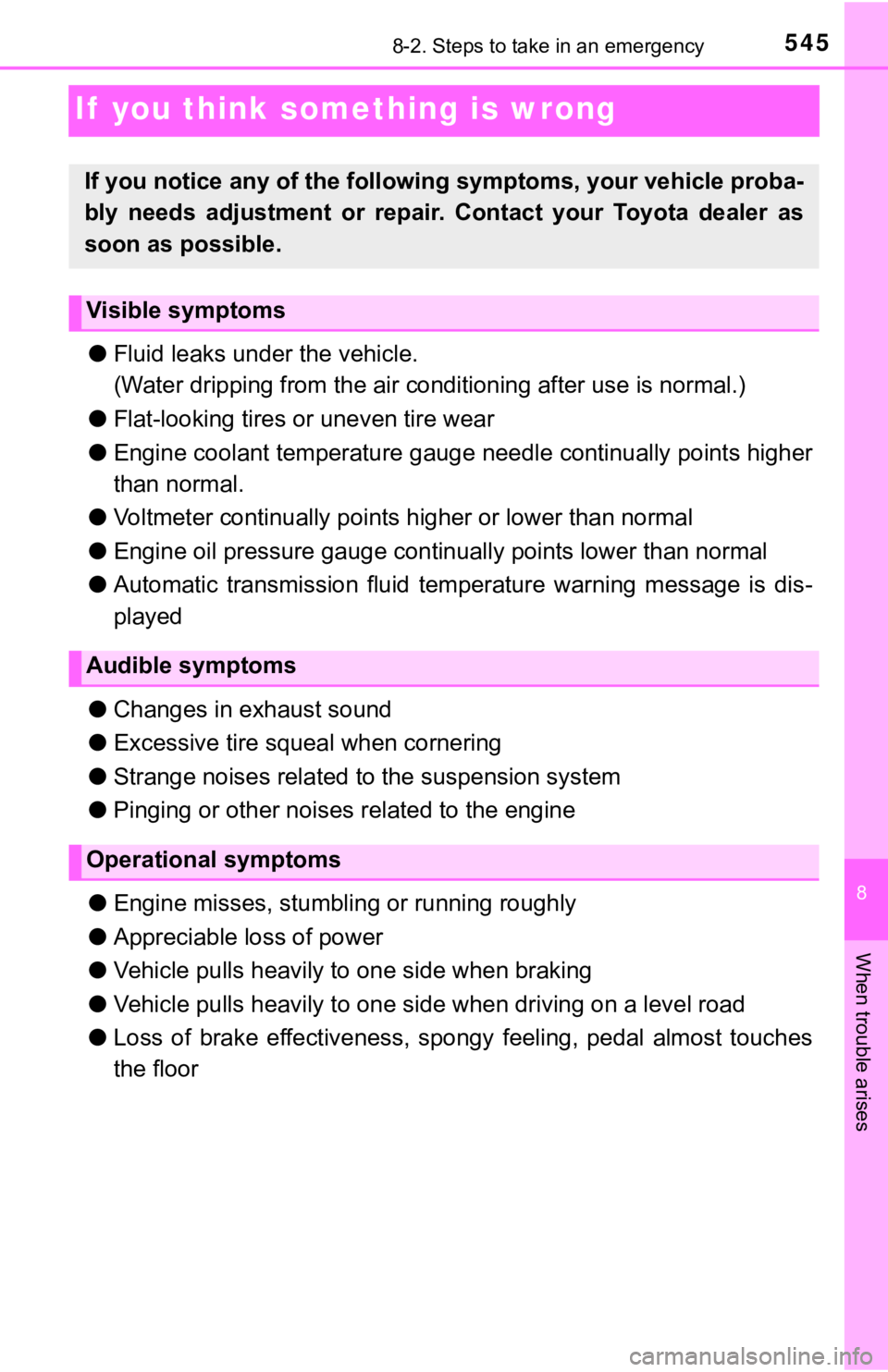Page 485 of 672
4857-3. Do-it-yourself maintenance
7
Maintenance and care
Engine compartment
Washer fluid tank (P. 494)
Engine oil level dipstick ( P. 486)
Engine coolant reservoir ( P. 488)
Engine oil filler cap ( P. 487)
Brake fluid reservoir ( P. 490) Fuse box (
P. 518)
Battery ( P. 492)
Radiator ( P. 490)
Cooling fan
Condenser ( P. 490)
Power steering fluid reservoir ( P. 491)1
2
3
4
5
6
7
8
9
10
11
Page 488 of 672

4887-3. Do-it-yourself maintenance
The coolant level is satisfactory if it is between the “FULL” a nd “LOW”
lines on the reservoir wh en the engine is cold.
Reservoir cap
“FULL” line
“LOW” line
If the level is on or below the
“LOW” line, add coolant up to
the “FULL” line. ( P. 585)
WARNING
■Used engine oil
● Used engine oil contains potentially harmful contaminants which may
cause skin disorders such as inflammation and skin cancer, so c are
should be taken to avoid prolonged and repeated contact. To remove used
engine oil from your skin, wash thoroughly with soap and water.
● Dispose of used oil and filters only in a safe and acceptable m anner. Do
not dispose of used oil and filters in household trash, in sewe rs or onto the
ground.
Call your Toyota dealer, service station or auto parts store fo r information
concerning recycling or disposal.
● Do not leave used engine oil within the reach of children.
NOTICE
■To prevent serious engine damage
Check the oil level on a regular basis.
■ When replacing the engine oil
● Be careful not to spill engine oil on the vehicle components.
● Avoid overfilling, or the engine could be damaged.
● Check the oil level on the dipstick every time you refill the v ehicle.
● Be sure the engine oil filler cap is properly tightened.
Engine coolant
1
2
3
Page 489 of 672

4897-3. Do-it-yourself maintenance
7
Maintenance and care
■Coolant selection
Only use “Toyota Super Long Life Coolant” or a similar high quality ethylene
glycol based non-silicate, non-amine, non-nitrite, and non-bora te coolant with
long-life hybrid organic acid technology.
U.S.A.:
“Toyota Super Long Life Coolant” is a mixture of 50% coolant and 50% deion-
ized water. (Minimum temperature: -31 F [-35 C])
Canada:
“Toyota Super Long Life Coolant” is a mixture of 55% coolant and 45% deion-
ized water. (Minimum temperature: -44 F [-42 C])
For more details about coolant, contact your Toyota dealer.
■ If the coolant level drops within a short time of replenishing
Visually check the radiator, hoses, engine coolant reservoir ca p, drain cock
and water pump.
If you cannot find a leak, have your Toyota dealer test the cap and check for
leaks in the cooling system.
WARNING
■ When the engine is hot
Do not remove the radiator cap.( P. 587)
The cooling system may be under pressure and may spray hot coolant if the
cap is removed, causing serious injuries, such as burns.
NOTICE
■ When adding coolant
Coolant is neither plain water nor straight antifreeze. The cor rect mixture of
water and antifreeze must be used to provide proper lubrication , corrosion
protection and cooling. Be sure to read the antifreeze or coolant label.
■ If you spill coolant
Be sure to wash it off with water to prevent it from damaging p arts or paint.
Page 545 of 672

545
8
When trouble arises
8-2. Steps to take in an emergency
If you think something is wrong
●Fluid leaks un der the vehicle.
(Water dripping from the air conditioning a fter use is normal.)
● Flat-looking tires or uneven tire wear
● Engine coolant temperature gauge needle continually points high er
than normal.
● Voltmeter continually points higher or lower than normal
● Engine oil pressure gauge cont inually points lower than normal
● Automatic transmission fluid temperature warning message is dis -
played
● Changes in exhaust sound
● Excessive tire squeal when cornering
● Strange noises related to the suspension system
● Pinging or other noises related to the engine
● Engine misses, stumbli ng or running roughly
● Appreciable loss of power
● Vehicle pulls heavily to one side when braking
● Vehicle pulls heavily to one s ide when driving on a level road
● Loss of brake effectiveness, spongy feeling, pedal almost touch es
the floor
If you notice any of the followi ng symptoms, your vehicle proba -
bly needs adjustment or repair. Contact your Toyota dealer as
soon as possible.
Visible symptoms
Audible symptoms
Operational symptoms
Page 556 of 672
![TOYOTA TUNDRA 2018 Owners Manual (in English) 5568-2. Steps to take in an emergency
(If equipped)
Indicates that the vehicle has deviated from the
lane (while the LDA [Lane Departure Alert] sys-
tem is operating).• The lane line TOYOTA TUNDRA 2018 Owners Manual (in English) 5568-2. Steps to take in an emergency
(If equipped)
Indicates that the vehicle has deviated from the
lane (while the LDA [Lane Departure Alert] sys-
tem is operating).• The lane line](/manual-img/14/43029/w960_43029-555.png)
5568-2. Steps to take in an emergency
(If equipped)
Indicates that the vehicle has deviated from the
lane (while the LDA [Lane Departure Alert] sys-
tem is operating).• The lane line on the side the vehicle hasdeviated from flashes in Yellow.
• A buzzer also sounds.
Check around the vehicle and back to
inside of the lane lines.
(Flashes)
Indicates that the engine was stopped with the
shift lever not in P.
A buzzer also sounds.
Shift the shift lever to P.
(Flashes)
Indicates that the engine was stopped while driv-
ing.
A buzzer also sounds.
Stop the vehicle in a safe place such as the
shoulder of a road.
Indicates that the engine coolant temperature is
too high
A buzzer also sounds.
Immediately stop the vehicle in a safe place
and contact your Toyota dealer.
Indicates a malfunction in the automatic transmis-
sion system
A buzzer also sounds.
Have the vehicle inspected by your Toyota
dealer immediately.
Warning messageDetails/Actions
(Yellow/
flashes)
Engine Stopped
Shift Into P
Engine Stopped
Stop In a Safe Place
Engine Coolant
Temp High
Stop in a Safe Place
See Owner’s Manual
CHECK
TRANSMISSION
SYSTEM
Page 585 of 672
585
8
When trouble arises
8-2. Steps to take in an emergency
If your vehicle overheats
●The needle of the engine coolant temperature gauge ( P. 9 5 )
enters the red zone or a loss of engine power is experienced. ( For
example, the vehicle speed does not increase.)
● “ENGINE COOLANT OVERTEMP” is shown on the multi-informa-
tion display.
● Steam comes out f rom under the hood.
Stop the vehicle in a safe place and turn off the air condition ing sys-
tem, and then stop the engine.
If you see steam:
Carefully lift the hood after the steam subsides.
If you do not see steam:
Carefully lift the hood.
After the engine has cooled
down sufficiently, inspect the
hoses and radiator core (radia-
tor) for any leaks. Radiator
Cooling fan
If a large amount of coolant leaks,
immediately contact your Toyota
dealer.
The following may indicate that your vehicle is overheating:
Correction procedures
1
2
3
1
2
Page 586 of 672
5868-2. Steps to take in an emergency
The coolant level is satisfactory
if it is between the “FULL” and
“LOW” lines on the reservoir.Reservoir
“FULL”
“LOW”
Radiator cap
Add coolant if necessary.
Water can be used in an emer-
gency if coolant is unavailable.
Start the engine to check that the radiator cooling fan operate s and
to check for coolant leaks from the radiator or hoses.
If the fan is not operating:
Stop the engine immediately and contact your Toyota dealer.
If the fan is operating:
Have the vehicle ins pected at the nearest Toyota dealer.
4
1
2
3
4
5
6
7
Page 587 of 672
5878-2. Steps to take in an emergency
8
When trouble arises
WARNING
■When inspecting under th e hood of your vehicle
Observe the following precautions.
Failure to do so may result in serious injury such as burns.
● If steam is seen coming from under the hood, do not open the ho od until
the steam has subsided. The engine compartment may be very hot.
● Keep hands and clothing away from the fans, etc., while the engine is run-
ning.
● Do not loosen the radiator cap and the coolant reservoir cap wh ile the
engine and radiator are hot.
High temperature steam or coolant could spray out.
NOTICE
■ When adding engine coolant
Add coolant slowly after the engine has cooled down sufficientl y. Adding
cool coolant to a hot engine too quickly can cause damage to th e engine.
■ To prevent damage to the cooling system
Observe the following precautions:
● Avoid contaminating the coolant with foreign matter (such as sa nd or dust,
etc.).
● Do not use any coolant additives.